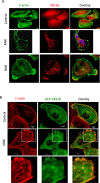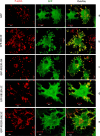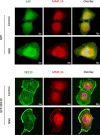XB130 translocation to microfilamentous structures mediates NNK-induced migration of human bronchial epithelial cells
- PMID: 25980441
- PMCID: PMC4627235
- DOI: 10.18632/oncotarget.3777
XB130 translocation to microfilamentous structures mediates NNK-induced migration of human bronchial epithelial cells
Abstract
Cigarette smoking contributes to the pathogenesis of chronic obstructive pulmonary disease and lung cancer. Nicotine-derived nitrosamine ketone (NNK) is the most potent carcinogen among cigarette smoking components, and is known to enhance migration of cancer cells. However, the effect of NNK on normal human bronchial epithelial cells is not well studied. XB130 is a member of actin filament associated protein family and is involved in cell morphology changes, cytoskeletal rearrangement and outgrowth formation, as well as cell migration. We hypothesized that XB130 mediates NNK-induced migration of normal human bronchial epithelial cells. Our results showed that, after NNK stimulation, XB130 was translocated to the cell periphery and enriched in cell motility-associated structures, such as lamellipodia, in normal human bronchial epithelial BEAS2B cells. Moreover, overexpression of XB130 significantly enhanced NNK-induced migration, which requires both the N- and C-termini of XB130. Overexpression of XB130 enhanced NNK-induced protein tyrosine phosphorylation and promoted matrix metalloproteinase-14 translocation to cell motility-associated cellular structures after NNK stimulation. XB130-mediated NNK-induced cell migration may contribute to airway epithelial repair; however, it may also be involved in cigarette smoking-related chronic obstructive pulmonary disease and lung cancer.
Keywords: F-actin association; airway epithelial cell migration; cortactin; intracellular signal transduction.
Figures








Similar articles
-
Stimulus-dependent dissociation between XB130 and Tks5 scaffold proteins promotes airway epithelial cell migration.Oncotarget. 2016 Nov 22;7(47):76437-76452. doi: 10.18632/oncotarget.13261. Oncotarget. 2016. PMID: 27835612 Free PMC article.
-
Adaptor protein XB130 is a Rac-controlled component of lamellipodia that regulates cell motility and invasion.J Cell Sci. 2010 Dec 1;123(Pt 23):4156-69. doi: 10.1242/jcs.071050. J Cell Sci. 2010. PMID: 21084565
-
Tobacco-specific carcinogen 4-(methylnitrosamino)-1-(3-pyridyl)-1-butanone (NNK) induces cell proliferation in normal human bronchial epithelial cells through NFkappaB activation and cyclin D1 up-regulation.Toxicol Appl Pharmacol. 2005 Jun 1;205(2):133-48. doi: 10.1016/j.taap.2004.09.019. Epub 2005 Jan 8. Toxicol Appl Pharmacol. 2005. PMID: 15893541
-
Understanding tobacco smoke carcinogen NNK and lung tumorigenesis.Int J Oncol. 2006 Oct;29(4):745-52. Int J Oncol. 2006. PMID: 16964372 Review.
-
Bcl2 Family Functions as Signaling Target in Nicotine-/NNK-Induced Survival of Human Lung Cancer Cells.Scientifica (Cairo). 2014;2014:215426. doi: 10.1155/2014/215426. Epub 2014 May 20. Scientifica (Cairo). 2014. PMID: 24967145 Free PMC article. Review.
Cited by
-
Cortactin in Lung Cell Function and Disease.Int J Mol Sci. 2022 Apr 21;23(9):4606. doi: 10.3390/ijms23094606. Int J Mol Sci. 2022. PMID: 35562995 Free PMC article. Review.
-
XB130/Tks5 scaffold protein interaction regulates Src-mediated cell proliferation and survival.Mol Biol Cell. 2015 Dec 1;26(24):4492-502. doi: 10.1091/mbc.E15-07-0483. Epub 2015 Oct 7. Mol Biol Cell. 2015. PMID: 26446840 Free PMC article.
-
Heterogeneous nuclear ribonucleoprotein C promotes non-small cell lung cancer progression by enhancing XB130 mRNA stability and translation.Cancer Cell Int. 2025 Jan 13;25(1):10. doi: 10.1186/s12935-025-03638-9. Cancer Cell Int. 2025. PMID: 39800708 Free PMC article.
-
Assessment of E-cigarette impact on smokers: The importance of experimental conditions relevant to human consumption.Proc Natl Acad Sci U S A. 2018 Apr 3;115(14):E3073-E3074. doi: 10.1073/pnas.1801967115. Epub 2018 Mar 13. Proc Natl Acad Sci U S A. 2018. PMID: 29535226 Free PMC article. No abstract available.
-
XB130 Deficiency Causes Congenital Hypothyroidism in Mice due to Disorganized Apical Membrane Structure and Function of Thyrocytes.Thyroid. 2021 Nov;31(11):1650-1661. doi: 10.1089/thy.2021.0195. Thyroid. 2021. PMID: 34470464 Free PMC article.
References
-
- Jemal A, Murray T, Samuels A, Ghafoor A, Ward E, Thun MJ. Cancer statistics, 2003. CA Cancer J Clin. 2003;53:5–26. - PubMed
-
- West KA, Linnoila IR, Belinsky SA, Harris CC, Dennis PA. Tobacco carcinogen-induced cellular transformation increases activation of the phosphatidylinositol 3′-kinase/Akt pathway in vitro and in vivo. Cancer Res. 2004;64:446–451. - PubMed
Publication types
MeSH terms
Substances
Grants and funding
LinkOut - more resources
Full Text Sources
Other Literature Sources

